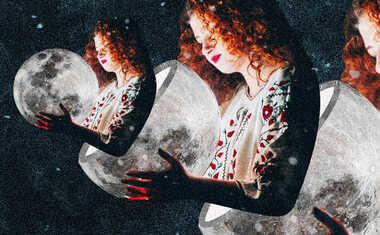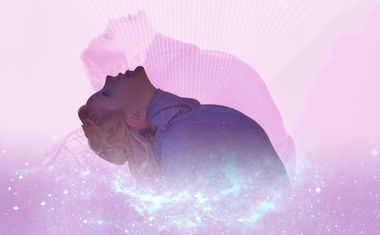
Iconology of the Moon Cards
From the Iconology Section of the Robert O'Neill Library
Introduction
There are seven extant Moon cards from the 15/16th century (Fig. 1). Three of the cards show astrologers observing the moon and taking measurements.
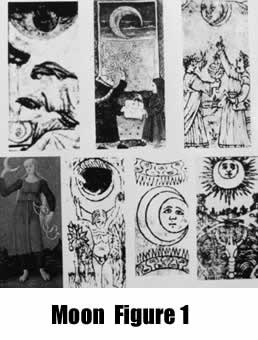 Two cards show a figure holding up the Moon. One shows simply the Moon. One shows a lobster/crayfish in a pond between 2 towers. Three of the cards show a face on the Moon and there is no particular consistency in the orientation of the crescent Moon.
Two cards show a figure holding up the Moon. One shows simply the Moon. One shows a lobster/crayfish in a pond between 2 towers. Three of the cards show a face on the Moon and there is no particular consistency in the orientation of the crescent Moon.
As we saw with the Star card, it is not unusual to find a figure holding aloft a heavenly body. Figure 2 shows the image of Luna from the so-called Tarocchi del Mantegna ~1470. Another example, probably from the 13th century, can be found in Seznec (1953, fig. 64).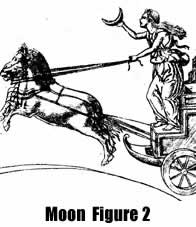
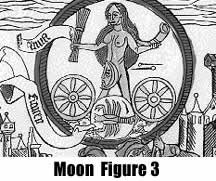 Figure 3 shows an image from a blockbook of the the Planents and their children. In this case, Luna is represented as a naked woman with the moon covering her genitals. The constellation associated with the Moon, cancer, is depicted as a lobster/crayfish similar to the early Tarot image. Notice the image also shows towers to each side as we find in the Tarot card. Williams (1994, p. 116) shows a similar image from the 15th century.
Figure 3 shows an image from a blockbook of the the Planents and their children. In this case, Luna is represented as a naked woman with the moon covering her genitals. The constellation associated with the Moon, cancer, is depicted as a lobster/crayfish similar to the early Tarot image. Notice the image also shows towers to each side as we find in the Tarot card. Williams (1994, p. 116) shows a similar image from the 15th century.
Religious tradition
Images of the Moon appear in many biblical illustrations. Usually the Moon appears just as another of the heavenly bodies. Figure 4 shows an illustration of Genesis from ~1240 with God instructing Adam on the Heavens.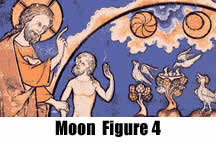
The moon also appears in illustrations of Psalm 148 (Fig. 5):
"Let the Heaven praise God...
Praise him, sun and moon,
Praise him, shining stars,
Praise him highest heavens..."
Apocalyptic tradition
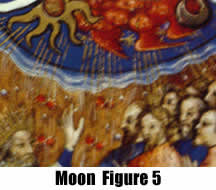 As with the other heavenly bodies, the Moon frequently appears in illustrations of John's Revelations. Figure 6 shows a Durer woodcut illustrating Rev. 6:12 "In my vision, when he broke the sixth seal...the moon turned red as blood..."
As with the other heavenly bodies, the Moon frequently appears in illustrations of John's Revelations. Figure 6 shows a Durer woodcut illustrating Rev. 6:12 "In my vision, when he broke the sixth seal...the moon turned red as blood..."
Figure 7 shows a small detail from a 13th century illustration of the angel blowing the fourth trumpet. A similar image can be found in a 14th century Cloisters apocalypse (Fig. 8).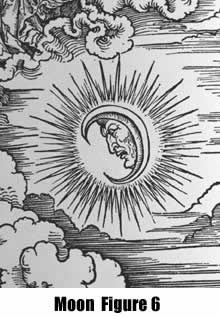
Iconological analysis
As with the Star card, the image of the Moon alone must have seemed too simple to the woodcarver and only one card shows the Moon in isolation. Three of the cards obviously draw out the relationship with astrology. This is not surprising because of the important of the Moon to the astrological and cosmological speculations of the times (Koestler 1959).
On one of the cards, the figure holding up the Moon also appears to have a broken bow in her hand. This is probably a reference to the goddess Diana. Seznec (1953) indicates that Diana was often represented as holding a bow and was closely identified with the Moon.
The following URL shows a 3/4th century image of either Luna or Diana with crescent moon at forehead: www.metmuseum.org
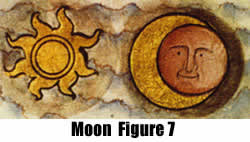 It is also interesting to note that Diana was often depicted together with Apollo, the Sun god of the following Tarot card (Seznec 1953).
It is also interesting to note that Diana was often depicted together with Apollo, the Sun god of the following Tarot card (Seznec 1953).
The presence of the goddess Diana on a single 15th century card has another interesting implication. The renewed interest in Roman and Greek mythology, called Humanism, was a characteristic of the late Medieval and Renaissance Periods. But this fascination with ancient culture was largely restricted to the literate aristocracy. Therefore, it is probably not surprising to find the bow with its subtle reference to Latin mythology on one of hand-painted decks produced for the ducal family in Milan. It is unlikely that the reference to Diana would have been meaningful to the ordinary card-player.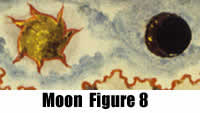
Interpretation
The modern scientific critic might be sceptical about the influence of the constellations on human life. But there is little basis for scepticism with the Moon. The tides, menstral cycles, and our structuring of time into months is ample evidence for the influence of the Moon on our lives.
Aristotle had held that the celestial bodies were were not made of the four elements but were more perfect and composed of a fifth element. Late Medieval theology had pretty much settled on a Platonic concept that held the Moon to be very much an earth-like world (Duhem 1985). This probably enhanced the popular belief in the astrological influence of the Moon. The prevalence of such beliefs seems to explain why three of the early cards show astrologers.
Although the card-players may have been only vaguely aware of the speculations of the philosophers and cosmologists (Koestler 1959), they certainly associated the Moon with folklore and superstition. The night, ruled by the Moon, was a time of mystery and magic. One route to understanding the nature of these beliefs is the Medieval Penitentials - works of pastoral care produced to assist the parish priest in the confessional. The priest was instructed in which questions to ask and which penances to assign (Gurevich 1988). The confessor is encouraged to ask questions about participation in monthly magical rituals to rekindle the light in the moon. Other questions deal with superstitious practices, witches, etc. The presence of such questions indicates that the priest is likely to encounter these beliefs in the popular culture. Given such evidence, it seems safe to assume that the card-players might have thought of magic or 'things that go bump in the night' when viewing this card.
Though we cannot develop the topic in full detail here, the card-players would also have been aware of the "ascent to heaven" as a mystical experience that had been recorded in Scriptures from Daniel to Revelations (Himmelfarb 1993). This mystical ascent or "enlightenment" is often described in the mystical literature as the spirit's ascent through the heavenly spheres. The card-players would have encountered the concept in sermons, particularly in feast days celebrating the Assumption of Mary and Ascension of Jesus. The liturgy for such feasts drew heavily on Old and New Testament visionary references and would commonly have formed the subject matter of the homily.

